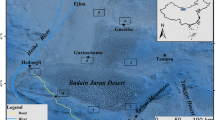Abstract
Mangrove vegetation and soil were analysed with a view to understanding the community structure and soil relationship in mangrove ecosystems. Coverage values of all plants, frequency, density and basal area for trees were obtained. Soil properties measured included pH, field moisture, bulk density, organic carbon, Al3+, SO4 2- and Cl-. Principal components ordination of the vegetation data established six mixed mangrove community types. All soil properties varied significantly between the community types, but was most marked in the cases of CO3 2- and SO4 2+. Several tree species showed variation in dominance and density across the community types. Rank correlation of soil with vegetation ordination axes revealed greater correlation along Axis 1 than higher order axes. Soil Cl- was observed to markedly correlate with hyperspace locations of Nypa fruticans, Avicennia africana, Rhizophora mangle and Acrostichum aureum communities. Soil classification showed that several soil properties could serve as indicators for community type differentiation. Additional environmental factors influencing mangrove distribution were inferred from the ordination patterns.
Similar content being viewed by others
References
Bardsley, C. E. & Lancaster, J. D. 1965. Sulphur. In: C. A., Black (ed.). Methods of soil analysis, part 2. Agronomy 9: 1102–1116. Madison, Wisconsin: American Society of Agronomy.
Bernard, J. M., Seischab, F. K. & Gauch, H. G. 1983. Gradient analysis of the vegetation of the Byron-Bergen Swamp a rich fern in Western New York, Vegetatio 53: 85–91.
Chapman, V. J. 1976. Mangrove vegetation. J. Cramer Publ. Co., Vaduz.
Cintron, G., Lugo, A. E., Pool, D. J. & Morris, G. 1978. Mangroves of aric environments in Puerto Rico and adjacent islands. Biotropica 10: 110–121.
Clarke, D. L. & Hannon, N. J. 1967. The mangrove swamps and salt marsh communities of the Sydney district 1. Vegetation, soils and climate. J. Ecol. 55: 752–771.
Conover, W. J. 1980. Practical non-parametric statistics J. Wiley, New York.
Fagbami, A. A., Udo, E. J. & Odu, C. I. I. 1988. Vegetation damage in an oil field in the Niger Delta of Nigeria. J. Trop. Ecol. 4: 61–75.
Giglioli, M. E. & Thornton, I. 1965. The mangrove swamps of Keneba, Lower Gambia River Basin 1. Descriptive notes on climate, the mangrove swamps and the physical composition of their soils. J. Appl. Ecol. 2: 81–104.
Gregory, S. 1974. Statistical methods and the geographer. Longman, London.
Hart, M. G. R. 1962. Observations on the source of acid in empoldered mangrove soils. I. Formation of elemental sulphur. Plant & Soil 17: 87–98.
Ibe, A. C. & Antia, E. E. 1983. Assessment of the Impact fo erosion along the Nigerian shoreline. Nigerian Institute for Oceanography and Marine Research. Tech. Pap. 13, Lagos.
Jackson, M. L. 1964. Notes on West African Vegetation I. Mangrove vegetation at Ikorodu, Western Nigeria, West Africa, Sci., Assoc. J. 9: 98–111.
Lindsay, A. A. 1956. Sampling methods and community attributes in forest ecology. Forest Science 2: 287–296.
Lugo, A. E. & Snedaker, S. C. 1974. The ecology of mangrove. Ann. Rev. Ecol. Syst. 5: 39–64.
Mercer, E. D. & Hamilton, L. S. 1984. Mangrove ecosystems: some economic and natural benefits. Nature and resources 20: 14–19.
Moorman, F. R. & Pons, L. J. 1974. Characteristics of mangrove soils in relation to their land use and potential. Proc. Internat. Symp. Biol. Management. Mangroves Honolulu, Hawai. 2: 526–547.
Mueller-Dombois, D. & Ellenberg, H. 1974. Aims and methods of vegetation ecology. J. Wiley, London.
Ukpong, I. E. 1991. The performance and distribution of species along soil salinity gradients of mangrove swamps in Southeastern Nigeria. Vegetatio 95: 63–70.
Ukpong, I. E. 1992. The structure and soil relations of Avicennia mangrove swamps in southeastern Nigeria. Trop. Ecol. 33: 1–16.
United States Salinity Laboratory Staff. 1969. Diagnosis and improvement of saline and alkaline soils. United States Department of Agric. Handbook 60.
Wikum, D. A. & Wali, M. K. 1974. Analysis of North Dakota gallery forest: vegetation in relation to topography and soil gradients. Ecol. Monogr. 44: 441–464.
Yuan, T. L. & Fiskell, J. G. A. 1959. Aluminium Studies: soil and plant analysis of aluminium by modification of the aluminium method. J. Agric. Food Chem. 7: 115–117.
Author information
Authors and Affiliations
Rights and permissions
About this article
Cite this article
Ukpong, I.E. An ordination study of mangrove swamp communities in West Africa. Vegetatio 116, 147–159 (1995). https://doi.org/10.1007/BF00045305
Accepted:
Issue Date:
DOI: https://doi.org/10.1007/BF00045305




